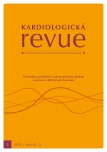Prediction and prevention of atherosclerosis and personalized treatment of dyslipidemia
Authors:
R. Češka; M. Prusíková; M. Šnejdrlová
Authors‘ workplace:
Centrum preventivní kardiologie, III. interní klinika 1. LF UK a VFN, Praha
Published in:
Kardiol Rev Int Med 2011, 13(2): 81-86
Overview
Atherosclerosis is the background of a pandemic of cardiovascular disease all over the world. It is a process that develops asymptomatically from childhood and is clinically manifested in middle or older age as, for instance, myocardial infarction, cerebrovascular accident or clinically evident involvement of other major vessels. How does one timely predict, prevent and cure atherosclerosis? These are the tasks of preventive cardiology. This article focuses on three areas: 1) risk factors, 2) diagnosis of subclinical atherosclerosis, 3) diagnosis and treatment of hyperlipoproteinemia and dyslipidemia as one of the major risk factors of atherosclerosis. Current medicine leans on several basic pillars. In the broadest sense, we can speak especially about evidence-based medicine. This is often the basis for general recommendations which apply to the whole population, or at least to a group of persons with the same diagnosis, disease or syndrome. On the other hand, these recommendations could result in such simplifying solutions as “one size fits all” and therefore, the other pole of the problem is being developed as well: tailored medicine, or personalized medicine, which takes into account the specific situation of each patient as far as possible. In fact, a really high quality approach is characterized by combining the general and individual approach. The article tries to outline this comprehensive approach based on an example of atherogenesis and the prevention of cardiovascular diseases.
Keywords:
atherosclerosis – risk factors – hyperlipoproteinemia – dyslipidemia – statins – niacin – fibrates
Sources
1. Cholesterol Treatment Trialists’ (CTT) Collaboration. Baigent C, Blackwell L, Emberson J et al. Efficacy and safety of more intensive lowering of LDL cholesterol: a metaanalysis of data from 170,000 participants in 26 randomised trials. Lancet 2010; 376 : 1670–1681.
2. Heinecke J. HDL and Cardiovascular-Disease Risk – Time for a New Approach? N Engl J Med 2011; 364: 170–171.
3. Keech AC, Mitchell P, Summanen PA et al. FIELD study investigators. Effect of fenofibrate on the need for laser treatment for diabetic retinopathy (FIELD study): a randomised controlled trial. Lancet 2007; 370: 1687–1697.
4. Joy T, Hegele RA. Is raising HDL a futile strategy for atheroprotection? Nat Rev Drug Discov 2008; 7 : 143–155.
5. Brousseau ME, Schaefer EJ, Wolfe ML et al. Effects of an inhibitor of cholesteryl ester transfer protein in HDL cholesterol. N Engl J Med 2004; 350 : 1505–1515.
6. Khera AV, Cuchel M, de la Llera-Moya M et al. Cholesterol efflux capacity, high density lipoprotein function and atherosclerosis. N Engl J Med 2011; 364: 127–135.
7. Buchwald H, Varco RL, Matts JP et al. Effect of partial ileal bypass surgery on mortality and morbidity from coronary heart disease in patients with hypercholesterolemia. Report of the Program on the Surgical Control of the Hyperlipidemias (POSCH). N Engl J Med 1990; 323 : 946–955.
8. Buchwald H, Varco RL, Boen JR et al. Effective lipid modification by partial ileal bypass reduced long-term coronary heart disease mortality and morbidity: five-year posttrial follow-up report from the POSCH. Program on the Surgical Control of the Hyperlipidemias. Arch Intern Med 1998; 158 : 1253–1261.
9. Cintra RR, Sposito AC. POSCH Trial 25-year Follow-up: Latest News From an Old Kid on the Results Block. Clin Lipidology 2010; 5 : 651–653.
10. Stary HC, Chandler AB, Dinsmore RE et al. A definition of advanced types of atherosclerotic lesions and a histological classification of atherosclerosis. A report from the Committee on Vascular Lesions of the Council on Arteriosclerosis, American Heart Association. Circulation 1995; 92 : 1355–1374.
11. Dobiášová M. Jakou informaci poskytuje aterogenní index plazmy o kardiovaskulárním riziku pacienta a jeho prognóze? Souč Klin Prax 2007; 6 : 15–19.
12. Leng GC, Fowkes FG, Lee AJ et al. Use of ankle brachial pressure index to predict cardiovascular events and death: a cohort study. BMJ 1996; 313 : 1440–1444.
13. Detrano R, Guerci AD, Carr JJ et al. Coronary calcium as a predictor of coronary events in four racial or ethnic groups. N Engl J Med 2008; 358 : 1336–1345.
14. Mitchell GF, Hwang SJ, Vasan RS et al. Arterial stiffness and cardiovascular events. The Framingham Heart Study. Circulation 2010; 121 : 505–511.
15. Maccubbin D, Bays HE, Olsson AG et al. Lipid-modifying efficacy and tolerability of extended-release niacin/laropiprant in patients with primary hypercholesterolaemia or mixed dyslipidaemia. Int J Clin Pract 2008; 62 : 1959–1970.
Labels
Paediatric cardiology Internal medicine Cardiac surgery CardiologyArticle was published in
Cardiology Review

2011 Issue 2
Most read in this issue
- Prediction and prevention of atherosclerosis and personalized treatment of dyslipidemia
- Individualized therapy of arterial hypertension
- Prediction and prevention of diabetes mellitus type 2
- A case of atypical heart failure
